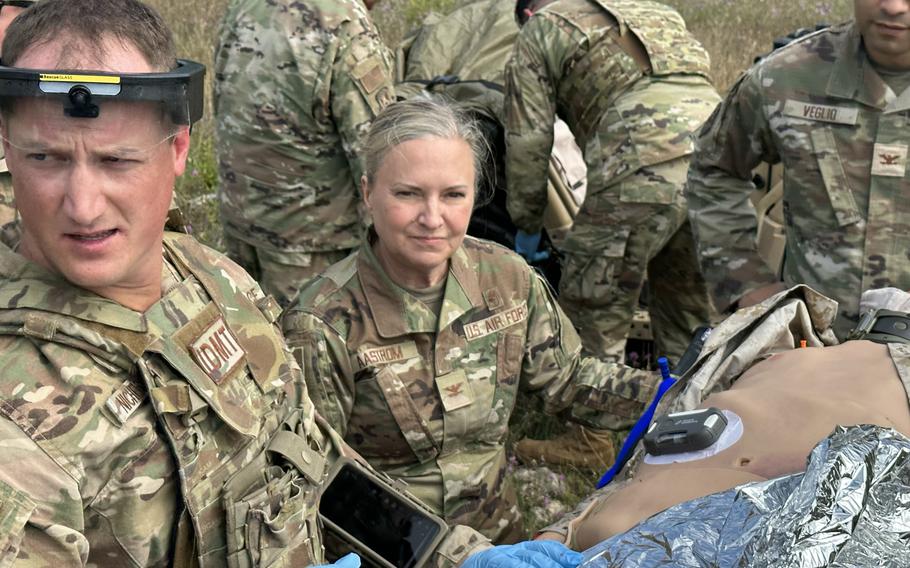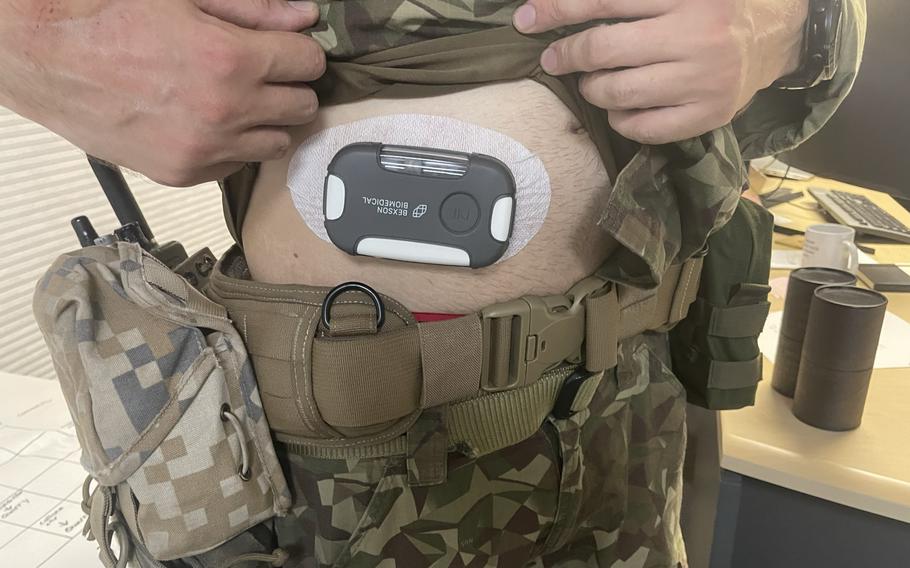
U.S. Army and Air Force medics tested a ketamine infuser device at a military exercise in Michigan in August. The device eventually could be used to provide pain relief on the battlefield. (Chani Devers / Michigan Air National Guard)
An infuser filled with a small amount of ketamine could relieve pain and even help save lives in future wars, say Air Force officials who have worked with the device.
The infuser produced by the small California-based company Bexson Biomedical was transported by a drone under simulated battlefield conditions at a military exercise in Michigan this summer.
Ketamine has received negative attention in recent decades because of its hallucinogenic properties when used illicitly as a recreational drug.
But its use as a short-term anesthetic goes back to the Vietnam War, and combat medics increasingly turned to ketamine as a pain reliever for patients with battlefield wounds during more recent U.S. wars. Its use increased from less than 1% of combat injuries up to 11% of such injuries in Iraq and Afghanistan from 2011 to 2016, according to a 2021 study published in the journal Military Medicine.
The military is interested in the new device because high casualty rates in a war might strain the ability of medics to keep up, said Air Force Lt. Col. David Brewer, program director of AIM-HI, an Air National Guard technology program.
“This technology is adaptive for what we anticipate contested wartime environments to look like in the future, if we saw casualty rates similar to that of what we’re seeing on the front lines of Ukraine,” Brewer said in a recent interview.

The ketamine infusion device is based on the same concept as insulin pumps, said Gregg Peterson, CEO of Bexson Biomedical, based in Santa Barbara, Calif. (Bexson Biomedical)
Ketamine is delivered intravenously by a needle. But poking a vein can take valuable time in a battlefield environment, Brewer said. The current way of delivering ketamine takes an average of eight minutes, while the device only needs 30 seconds to apply — time that would free up medics to save more people, he added.
Delivery with a needle also requires trained medics and saline solution, which might be in short supply in a war with mass casualties.
Five service members at AIM-HI who were assigned the task of improving combat field medicine learned about the ketamine device, which is similar to an insulin pump for diabetes patients, Brewer said. The device is attached to a person’s body and delivers medicine just under the top layer of skin.
They reached out to Bexson Biomedical in February about whether they could make a prototype for military use. The device has a preloaded cartridge with six milliliters of ketamine.
“Basically, the medic takes it right out of the blister pack, or in the civilian world, the patient takes it right out of the blister pack, slaps it on themselves, and literally presses the play button,” said Gregg Peterson, CEO of Bexson, in a recent interview.
In August, Bexson brought a ketamine-free version of the device to a military exercise in Michigan, dubbed Northern Strike. There, Army medics tested whether it was rugged enough to survive in the field. It was attached to dummies and fitted on people, as well put on a helicopter.
At one point, half a dozen devices were loaded onto a quadcopter drone, which flew 35 miles and delivered them.
Bexson has been invited to bring the device to future military exercises in Michigan and North Carolina, Peterson said. The company is still seeking FDA approval for their device and their ketamine formula, he said.
So far, the company has completed animal testing and plans to start human trials next year, he said.
Brewer said the military is working to get funding to help Bexson build a new working prototype. He added he is optimistic that the technology could be in the hands of medics within three to five years.